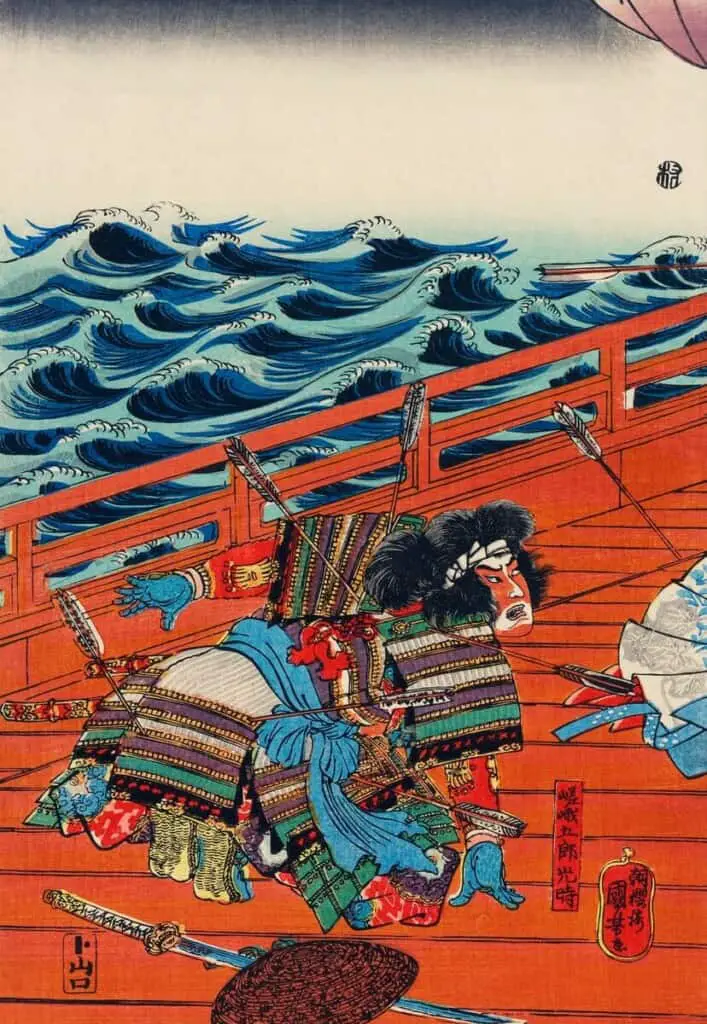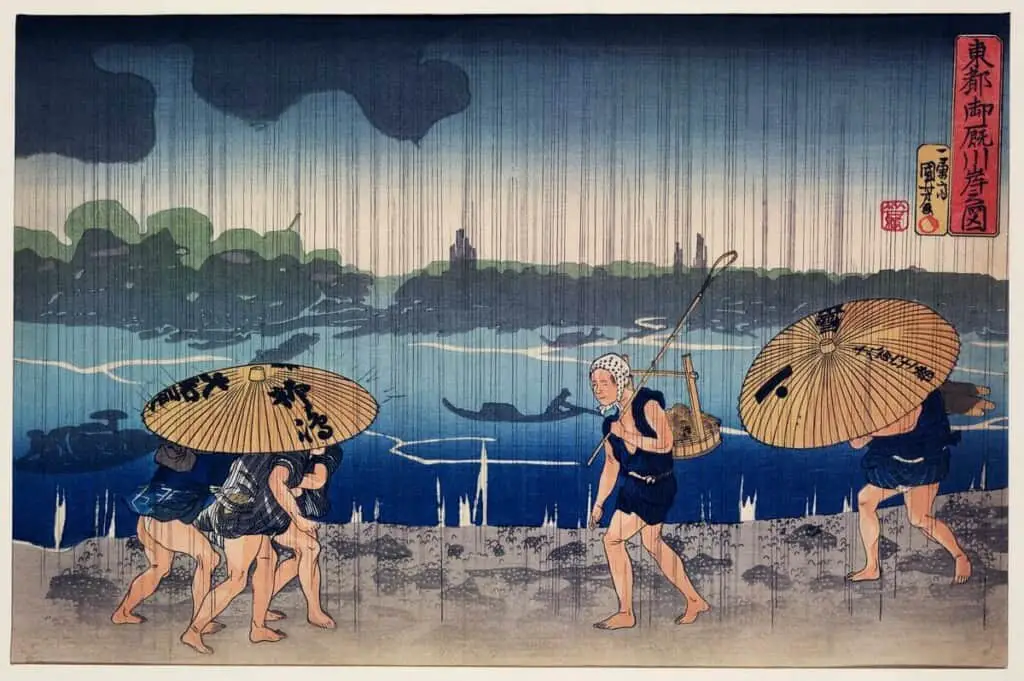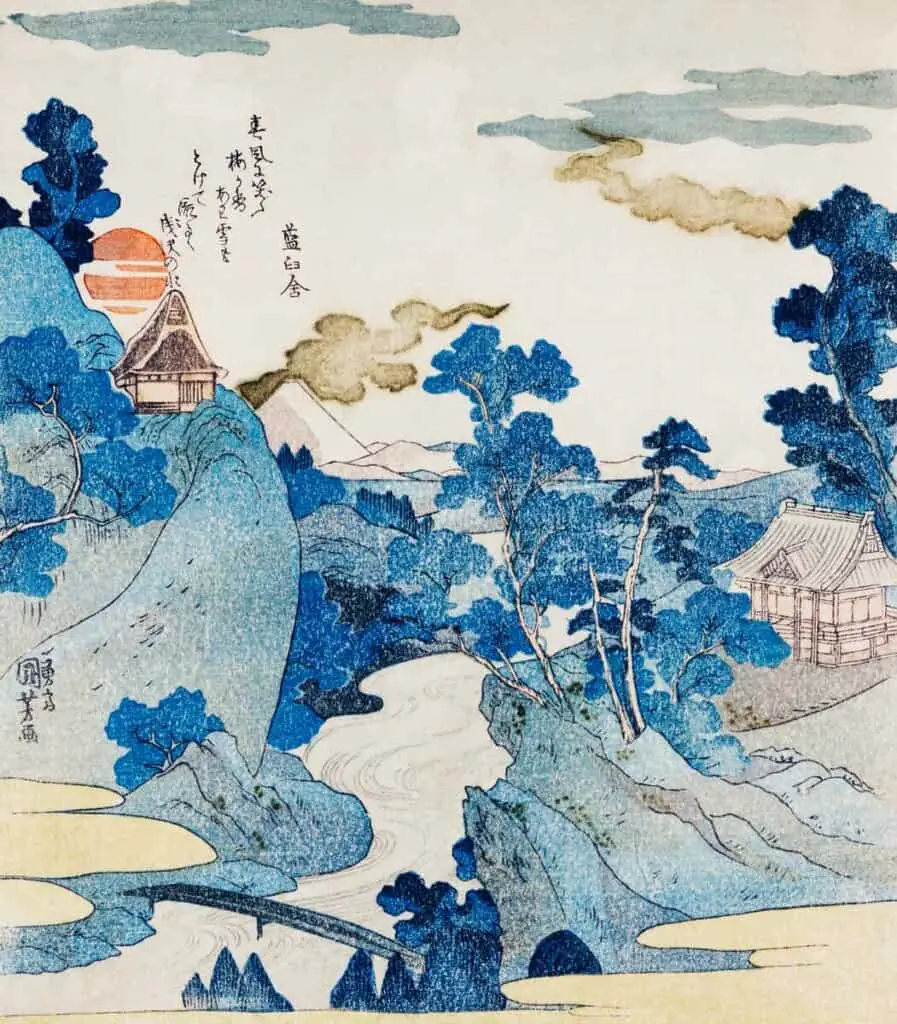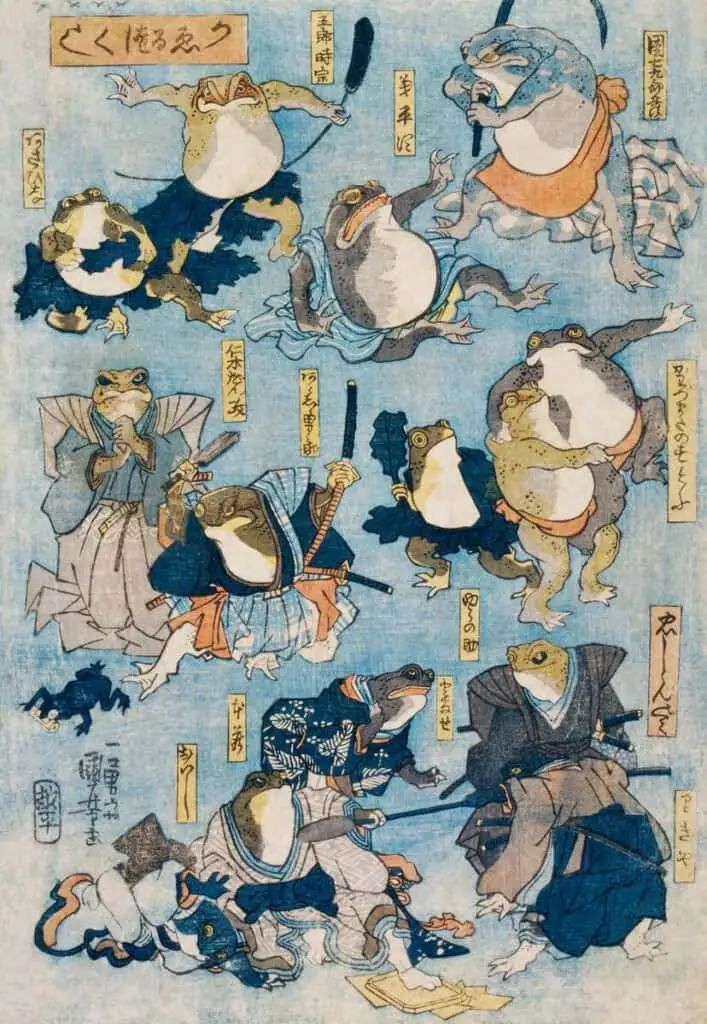Recently, I have become very fascinated with the Japanese art style of ukiyo-e woodblock prints. When I look at these woodblock prints and many of the colors and designs used, I am fascinated by how many of these prints are on trend today. Utagawa Kuniyoshi is one of the great artists of this Japanese art style of ukiyo-e woodblock prints.
Utagawa Kuniyoshi was a Japanese artist who was a ukiyo-e art style woodblock print master. His woodblock prints are artistic masterpieces. Kuniyoshi became an artist early in life, but success did not always come easy. He eventually became very popular as his artwork influenced the trends and fashions of his day. Kuniyoshi was known to have produced about 10,000 woodblock prints during his lifetime.
Table of Contents
- Who Is the Japanese Woodblock Print Artist Utagawa Kuniyoshi (1798 – 1861)?
- Warriors with Tattoos Popularity
- The Tempo Reforms, Art and Politics
- Frequently Asked Questions
- Related Questions

Who Is the Japanese Woodblock Print Artist Utagawa Kuniyoshi (1798 – 1861)?
Utagawa Kuniyoshi (1798 – 1861) was a prominent Japanese woodblock print artist celebrated for his significant contributions to the Ukiyo-e art style. Born in Edo (modern-day Tokyo), Kuniyoshi was a student of the renowned Utagawa school, a lineage that significantly shaped the world of Japanese woodblock printing.
His work is distinguished by its dynamic compositions, vivid detail, and often, a sense of dramatic intensity. Kuniyoshi mastered various subjects but is particularly revered for his depictions of historical events and legendary samurai tales, infusing them with a unique blend of realism and fantasy.
Kuniyoshi’s career spanned a critical period in Japanese art, where woodblock printing evolved from mere popular entertainment to a sophisticated, highly artistic medium. His works reflect the cultural and societal nuances of Edo-period Japan and showcase an innovative use of color and form.
He was adept at experimenting with perspective and foreshortening, techniques not commonly seen in Japanese art before his time. Kuniyoshi’s legacy extends beyond his striking prints; he influenced subsequent generations of Japanese artists and played a pivotal role in shaping the aesthetics of Ukiyo-e.
His art continues to captivate audiences worldwide, serving as a testament to his creative genius and the enduring appeal of traditional Japanese woodblock printing.
Utagawa Kuniyoshi’s Early Life
Kuniyoshi, originally named Yoshisaburo, started very early in life to become an artist. Born in Japan in 1798, his father, Yanagiya Kichiyemon, was a silk dyer. Kuniyoshi assisted his father’s business as a pattern designer, even at a very young age.
Because he was exposed to the textile business, many people have suggested that he used many textile patterns in his woodblock prints.
At about age 7 or 8, Kuniyoshi became very impressed with the ukiyo-e art style of warrior prints. The pictures of artisans and commoners influenced him. All of these subjects he would put into his own prints.
As early as age 12, Kuniyoshi’s talent was brought to the ukiyo-e print masters’ attention. He was officially admitted to the Utagawa school at age 13 (1811). He studied there until 1814 and was known to be one of their star pupils.
At the age of 16, he became an independent artist. During this time, he also started to publish his first works of art. He was undoubtedly one of the most promising young ukiyo-e artists during this period.
As is customary, he took on a new name or the artistic name of Utagawa Kuniyoshi. Utagawa was actually the name of the Utagawa School (Utagawa-Ryu)

The Utagawa School and Ukiyo-e Art
The Utagawa school was one of the leading art schools of the ukiyo-e art movement. Utagawa Toyoharu founded the school. It was one of the largest and most important ukiyo-e art schools of its time.
The Utagawa school was so successful that today, more than half of the surviving ukiyo-e prints are from this school.
The ukiyo-e art movement is a Japanese art form that flourished in the 17th to 19th centuries. The artist produced woodblock prints and paintings of subjects such as women, kabuki actors, sumo wrestlers, history, folk tales, travel, flora, fauna, landscapes, and erotica. The word ukiyo-e translates to mean “pictures of the floating world.”

Kuniyoshi’s Years of Economic Decline
For some reason, the years 1818 to 1827 were not very productive years for Kuniyoshi. We are not sure if this is due to a lack of paying art commissions from publishers, as there was too much competition from other artists or other personal reasons as to why he was not very productive.
At one point, his economic situation turned very desperate. To survive economically, he was forced to sell tatami mats. During this time, a chance encounter with a prosperous former fellow student, Kunisada, led Kuniyoshi to redouble his efforts to produce art and return to the art world.
He rightfully felt he had more artistic talent than Kunisada, yet he suffered so much more economically that he now had to sell tatami mats.

Warriors with Tattoos Popularity
In the 1820s, Kuniyoshi started to produce some art panels. These panels began to show his own individual artistic style. In 1827, he received his first big creative break with a significant commission for the series “One Hundred and Eight Heroes of the popular Sukioden All Told (Tsuzoku Suikoden goats hyakuhachinin no hitori).
Kuniyoshi drew individual heroes on single sheets of paper. Many of them had tattoos all over their bodies. This art and body tattoos influenced the Edo fashion of Japanese body tattoos.
His work became extremely popular in Edo, Japan. (Edo is the former name of present-day Tokyo, Japan). The demand for his warrior prints increased, which helped him gain entrance into the significant ukiyo-e and literary circles of this time. This newfound popularity and influence led to him being able to support himself as an artist.

The Tempo Reforms, Art and Politics
In 1842, the then-leader of Japan, Tokugawa Shogunate, introduced the Tempo Reforms. These reforms affected many people in Japan, from the military, economics, agriculture, financial, and religious groups. These reforms also affected the arts and artists in Japan.
The reform was instituted to help control the public display of luxury and wealth. Illustrations of courtesans and actors in the ukiyo-e art style were officially banned.
In speaking of this period of time, Ken Johnson, a New York Times writer, spoke about an essay by Timothy Clark, head of the Japanese Section of the British Museum for the Royal Academy of Arts in London; he wrote:
“The essay focuses on censorship imposed in Japan on artists and entertainers in the 1840s, a time when laws were passed prohibiting conspicuous displays of wealth, irreverence or negativity toward authority and anything sexually provocative, from portraits of famous courtesans to pornography. With the United States and other nations pressing for open trade with Japan, it was a time of political anxiety and economic flux, which prompted conservative efforts to control perceived excesses of popular culture.”
Ken Johnson
This time also influenced Kuniyoshi’s artwork as he started to use caricatures or other comic pictures to disguise some of the actual actors, courtesans, and people of the day. Kind of a bit of his own hidden message and rebellion to the time period through his artwork and prints.
In speaking of Kuniyoshi and the power of his art even today, Ken Johnson went on to say:
“As elegantly sumptuous as they are imaginatively extravagant, Kuniyoshi’s greatest prints represent turbulent, epic visions of human protagonists battling supernatural beings on three-page spreads two and a half feet across, a format he invented. He also made portraits of attractive women in fashionable clothes, kabuki actors, comical montages of anthropomorphized cats and octopuses, and antic, pornographic cartoons. Along with Hokusai and Hiroshige, he worked in a style known as ukiyo-e, or pictures of the floating world of leisure and luxury, which a rising population of middle-class hedonists avidly consumed.”
Ken Johnson
Interestingly, despite some of the controversy, his prints caused Kuniyoshi to continue producing a fantastic amount of artwork. Many of these prints would humorously criticize the Tokugawa Shogunate, Japan’s ruler of the day.
In speaking of Kuniyoshi and his contribution to the Japanese artwork of his day, Ken Johnson of the New York Times beautifully summed it up this way:
“The puritanical laws didn’t stop Kuniyoshi from producing some 10,000 prints by the time he died in his mid-60s in 1861, many of them technically virtuosic and flat-out gorgeous…we may ask ourselves: What might Kuniyoshi have wrought had he been free to do whatever he wanted?
Ken Johnson

Kuniyoshi was a master artist of the ukiyo-e style woodblock prints. He is a fantastic artist whose art we should continue to study and celebrate today. His art prints can be found in many major museums around the world.
Anita Louise Art is dedicated to art education, great artists, and inspiring others to find and create their art. We love art that uplifts and inspires. #ArtToMakeYouSmile! #ArtToMakeYouHappy!
If you want to see any of my art, you can find out more by clicking here. If you are interested in what inspires me and my paintings, you can discover more by clicking here.
We have a free newsletter and would love you to be part of our community; you can subscribe to the newsletter by clicking here. If you have any questions, I would be happy to talk to you anytime. You can reach me, Anita, by clicking here.
Subscribe to our Anita Louise Art YouTube Channel with great videos and information by clicking here.
Frequently Asked Questions
Who is Utagawa Kuniyoshi, and what is his significance in the world of Japanese woodblock prints?
Utagawa Kuniyoshi was a prominent Japanese artist specializing in the ukiyo-e woodblock print genre. His significance lies in his mastery of this traditional art form and his substantial impact on shaping the trends and fashions of his era through his unique artistic contributions.
What is the ukiyo-e art style, and how does Kuniyoshi’s work exemplify its characteristics?
Ukiyo-e is a traditional Japanese art style that emerged during the Edo period, known for its woodblock prints depicting scenes of landscapes, kabuki actors, beautiful women, and more. Kuniyoshi’s work showcases the distinctive features of ukiyo-e, including vibrant colors, intricate designs, and a focus on capturing the essence of everyday life.
How did Utagawa Kuniyoshi become involved in the world of art, particularly ukiyo-e woodblock prints?
Kuniyoshi started his artistic journey early in life, showing a talent for drawing. He eventually became a student of the ukiyo-e master Utagawa Toyokuni. Through years of dedication and practice, Kuniyoshi developed his unique style and contributed significantly to the evolution of ukiyo-e.
Can you elaborate on the challenges and successes that Utagawa Kuniyoshi experienced in his artistic career?
While success did not come easily for Kuniyoshi initially, his perseverance and talent eventually led to widespread recognition. He faced challenges in a competitive artistic environment but triumphed over them to become a highly popular and influential artist of his time.
How did Utagawa Kuniyoshi’s woodblock prints influence the trends and fashions of the period in which he lived?
Kuniyoshi’s art had a profound impact on the cultural and social trends of the Edo period. His depictions of kabuki actors, mythical creatures, and warriors not only reflected the popular culture but also played a role in shaping it. His prints were sought after and widely circulated, contributing to the dissemination of trends.
Approximately how many woodblock prints did Utagawa Kuniyoshi produce during his lifetime, and what themes were prevalent in his work?
Utagawa Kuniyoshi is estimated to have produced around 10,000 woodblock prints. His work covered a wide range of themes, including kabuki actors, landscapes, historical scenes, and mythical creatures. His versatility as an artist is reflected in the diversity of subjects he portrayed.
How does Utagawa Kuniyoshi’s artistic style differ from other ukiyo-e artists of his time?
Kuniyoshi’s style is characterized by bold compositions, dynamic poses, and a penchant for depicting warriors and mythical figures. While sharing some common elements with his contemporaries, his unique approach to form and subject matter sets him apart within the ukiyo-e artistic community.
Are there any specific techniques or innovations in woodblock printing associated with Utagawa Kuniyoshi?
Kuniyoshi experimented with various techniques, such as the use of bokashi (color gradation) and innovative compositions. His ability to convey movement and emotion through dynamic poses and detailed expressions contributed to the evolution of woodblock printing techniques.
How has Utagawa Kuniyoshi’s legacy endured over time, and what impact does his work have on contemporary art and design?
Kuniyoshi’s legacy persists through the continued admiration of his artistic achievements. His influence can be seen in contemporary art and design, with elements of his style often reinterpreted or referenced in modern works. The timeless appeal of ukiyo-e, exemplified by Kuniyoshi, continues to captivate audiences globally.
Where can one view or purchase Utagawa Kuniyoshi’s woodblock prints today, and are there any notable collections featuring his work?
Utagawa Kuniyoshi’s woodblock prints can be found in various museums, galleries, and private collections around the world. Some notable institutions with significant holdings of his work include the British Museum, the Museum of Fine Arts, Boston, and the Tokyo National Museum. Additionally, collectors and art enthusiasts may find opportunities to purchase prints through auctions, specialized dealers, and online platforms dedicated to Japanese woodblock prints.
Related Questions
How Do You Identify A Japanese Artist’s Signature on Woodblock Prints?
The signature on a Japanese woodblock print is the Japanese characters above or near the red artistic seal or chop. Sometimes the artist would add words behind their own name such as “designed by.” Other times the artist would use different chops or seals during different periods of their life. Many times the actual artist’s signatures are very difficult to read.
You can find out more by reading our blog How Do You Identify A Japanese Artist’s Signature on Woodblock Prints? by clicking here.
What Is The Great Wave Off Kanagawa by Japanese Artist Hokusai (1790-1849)?
The Japanese artist Hokusai produced The Great Wave Off Kanagawa woodblock print as part of his series called Thirty-six Views. The Great Wave off Kanagawa features a huge wave, a small Mount Fuji in the background, and three boats getting caught in the large wave. This print has remained so popular that it inspired music, poetry, and even a present-day emoji.
You can discover more by reading our blog The Great Wave Off Kanagawa by Japanese Artist Hokusai (1790-1849) by clicking here.

